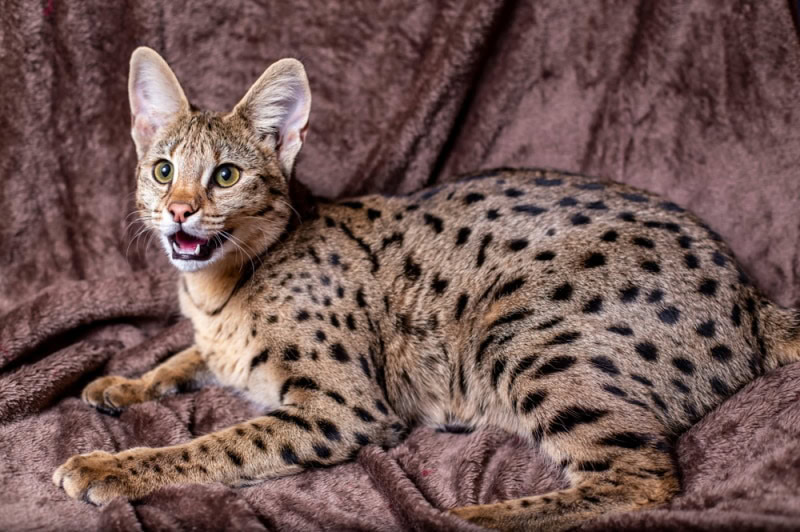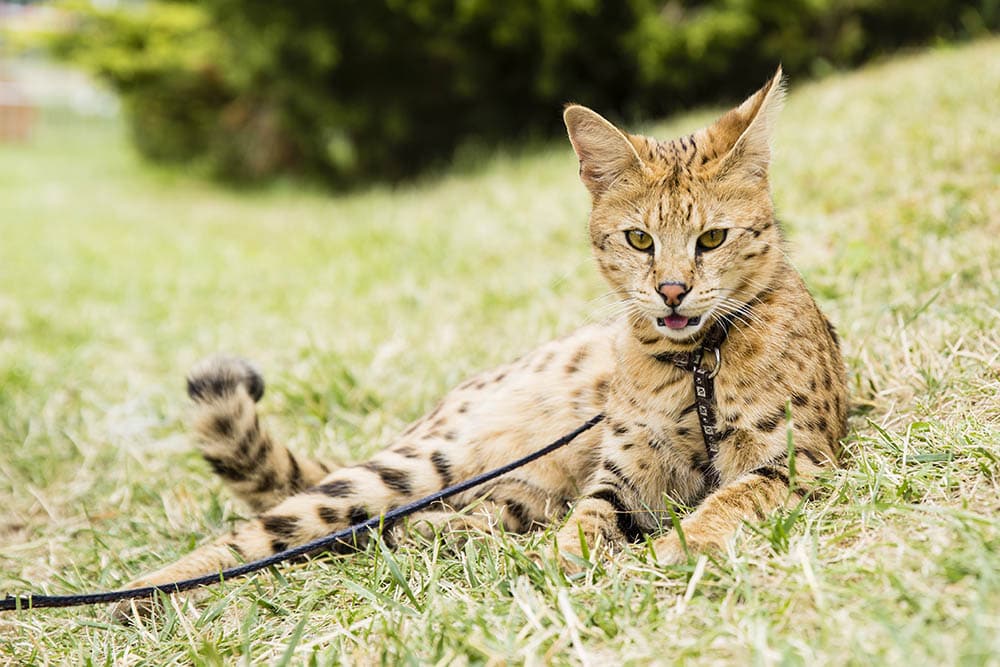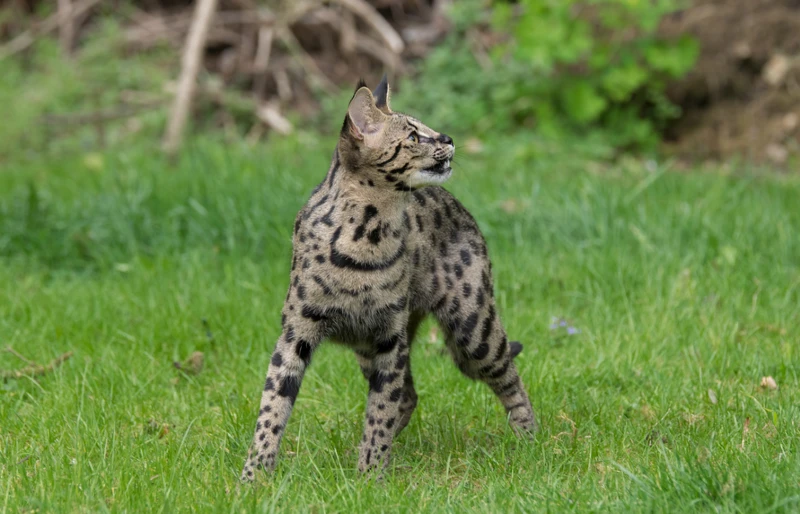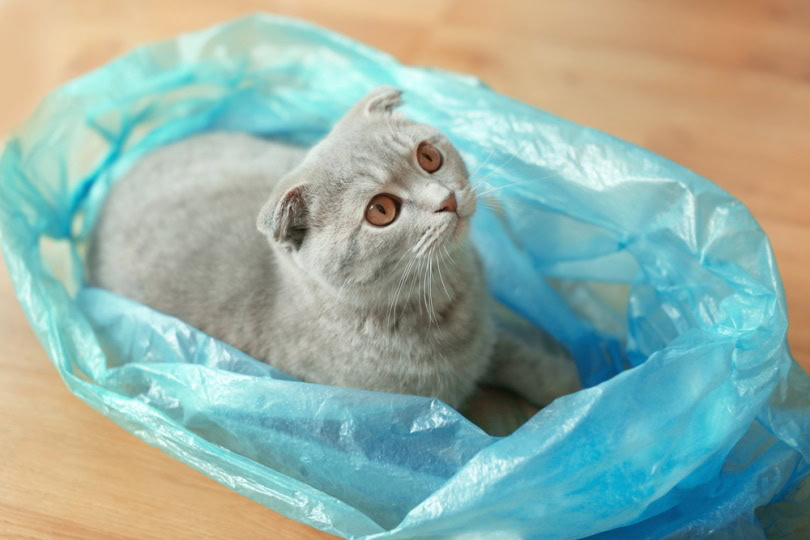VET APPROVED

The information is current and up-to-date in accordance with the latest veterinarian research.
Learn more »Click to Skip Ahead
As a newer crossbreed between the African Serval and the domestic feline, the Savannah Cat is the closest way for feline enthusiasts to own a wild cat that the law will allow. In fact, ownership is still not permitted in all places. For example, the state of Georgia, as well as New York City ban Savannah Cats entirely, while other places such as Vermont restrict ownership to F4 generations and later. Every subsequent generation loses some of the untamed qualities of the original mix, but the Savannah Cat is still noticeably different from domestic cats due to their physique and athletic abilities. The Savannah Cat can jump over 8 feet high, which is an average 3 feet taller than your average house cat. Let’s see how this interesting breed compares to similar animals to really gauge the awesomeness of this trait.

How High Can the Savannah Cat Jump Compared to Other Animals?
While the tabby on your porch might clear 8 feet if they’re in extremely good shape, the Savannah Cat regularly clears 8 feet and can possibly jump even higher. Their ancestor, the African Serval, can actually achieve a 9-foot jump. The average domestic cat can jump up to six times their height, which is still an impressive feat compared to other species. However, their wild ancestors have them beat by a long shot.
| Animal | Vertical Jump Height |
| Savannah Cat | 8 feet or more |
| Domestic Tabby Cat | 5 feet or more |
| African Serval | 9 feet |
| Golden Retriever | 4–6 feet |
| Adult Human | 1–3 feet |
| Rabbit | 2–4 feet |
| Dolphin | 15–30 feet |
While the cat may boast one of the tallest bounds on land, the dolphin is the reigning champion of the sea. They can soar up to 30 feet in the air above the water, which is why they’re so easily spotted during seaside vacations.
Of course, not every dolphin can jump 30 feet in the air, just as every human can’t leap up to 3 feet. The overall condition of the individual creature determines their jump more than their species. For example, the highest vertical jump a human accomplished was 8 feet. However, a modest 1–3 feet is average. Thus, some Savannah Cats may jump to a height closer to the Serval or other domestic cats, depending on their individual characteristics, including which generation or ‘filial number’ they are.
Representation of Savannah Filial Generations
- Serval x Domestic cat = F1 Savannah
- F1 x F1 = F2 Savannah
- F2 x F2 = F3 Savannah
- F3 x F3 = F4 Savannah ← considered purebred Savannah
→ The higher the number, the more removed they are from their wild ancestor.


How to Keep Your Savannah Cat Contained
Now that you know your Savannah Cat can breezily leap over your fence, let’s talk about how to keep them safely in your yard so they don’t become lost or hurt.
It’s important to keep in mind that the Savannah cat, particularly F1 and F2 crosses, has more in common with wild animals than your average domestic cat, and many animal welfare organizations strongly advise against keeping them as pets. The Savannah cat will not do well in confined spaces or small apartments, and if you wish to adopt one of these beautiful felines, you need to be able to keep them safe and enriched. Their prey drive is very strong, so containing your Savannah cat is important not just for their safety but for that of the local wildlife, too.
1. Keep Them Inside Unless You’re Watching Them
These very active and athletic cats need space, and lots of it. If you are going to open your home to a Savannah cat, it is important to make sure you have the right environment to do so. Cat enclosures, catios, enclosed catwalks, and window boxes are great ways to allow your wild-at-heart kitty to enjoy the outdoors safely, and furnishing your home with multilevel cat trees and shelves can help you make the most of your vertical spaces. If you have a suitable yard, enclosing all or part of it in cat-safe netting can allow your cat the freedom to play outside without the risks of escape.
2. Create Enclosed Outdoor Spaces
These very active and athletic cats need space, and lots of it. If you are going to open your home to a Savannah cat, it is important to make sure you have the right environment to do so. Cat enclosures, catios, enclosed catwalks, and window boxes are great ways to allow your wild-at-heart kitty to enjoy the outdoors safely, and furnishing your home with multilevel cat trees and shelves can help you make the most of your vertical spaces. If you have a suitable yard, enclosing all or part of it in cat-safe netting can allow your cat the freedom to play outside without the risks of escape.
3. Take Them on Walks with a Leash and Harness

Requiring at least 2 hours of daily exercise, the Savannah Cat needs more physical activity than your average cat. They can become restless if they’re stuck inside for too long, which will make them more determined to escape, so you should make sure they meet their exercise quota with a walk. You can train them to walk using a harness designed for cats, never a collar. Cats’ necks are too sensitive for collars and since they don’t have collarbones, they can easily slip away.
4 Motivate Them Indoors
In addition to their daily walk, your kitty should have plenty of indoor activities to keep them occupied. Catnip pouches, cat trees, and other feline-friendly toys are great ways to engage them in independent playtime.

Conclusion
Savannah Cats retain many traits of the wild African Serval. Although they can’t quite reach the 9-foot jump that’s possible from the Serval, they can still clear at least 8 feet, which is much higher than domestic cats and most land-dwelling mammals at large. If you’re lucky enough to care for a Savannah Cat, you should make sure your yard is secured so they can’t escape and take them on daily walks to release their enormous bounds of energy.
Featured Image Credit: Katerina Mirus, Shutterstock











